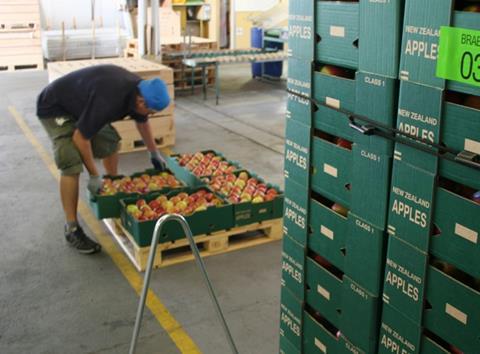
New Zealand is expected to ship around 310,000 tonnes of apples this season – a pleasantly surprising result for the country's growers during what is an off year in their trees' biennial bearing cycle.
Last year's full crop yielded a 12 per cent increase in shipments overseas to 324,684 tonnes, according to industry body Pipfruit NZ, and this year's export volumes had been expected to fall back in line with a downturn in production to around 480,500 tonnes.
However, exporters had already expressed confidence at the start of the 2014 campaign about the prospects for NZ apples, mainly based on the anticipated demand for smaller-sized fruit in key markets such as the UK and the fact that frosts in Chile and hail in South Africa would mean availability of those sizes was under pressure from the start of the season.
New Zealand's apple export trade has also been aided by a further increase in demand from the developing Asian market, where volumes sold to China and Hong Kong increased from 15,268 tonnes in 2012 to 21,443 tonnes last year, despite a temporary suspension of shipments in September.
The country's top five export markets in 2013 were the UK (44,312 tonnes), US (40,736), Netherlands (36,971), Thailand (27,784) and Belgium (26,418). A significant proportion of shipments to the Netherlands and Belgium were re-routed to other markets across Europe, with demand boosted by a smaller Northern Hemisphere crop and, again, damage to crops in Chile and South Africa.
Thailand, meanwhile, has emerged as one of the shining examples of successful market diversification: in just five years, it has gone from importing less than 8,000 tonnes of NZ apples to almost 28,000 tonnes in 2013.
Similar dramatic increases have been observed in the UAE, which imported 18,404 tonnes in 2013 – four times the 2008 figure; in India, up from 4,966 tonnes to 14,330 tonnes during the same period; and in Vietnam, now taking around 3,000-4,000 tonnes compared with just 750 five years before.
New Zealand also appears to be reaping the rewards of a sizeable increase in productivity as the sector has consolidated in the post-deregulation era.
Figures released by Pipfruit NZ show that, while planted area for apples has declined by nearly 25 per cent since 2005, production of export-grade fruit is at a similar, if not higher, level now to that seen a decade ago.



